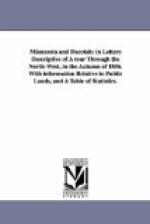The administration of justice is secured by a system which is now common to all the territories, with the exception of Kansas. The supreme court consists of the three district judges in full bench. They hold nisi prius terms in their respective districts, which are called district courts. The judges have a salary of $2000 each, and are appointed for a term of four years, subject to removal by the President. The district courts have chancery jurisdiction in matters where there is not a plain, adequate, and complete remedy at law. (Stat. of Min. ch. 94, sec. 1.) There are also probate courts. Each county has two justices of the peace, who are elected by the people. And I cannot but remark how much better the practice is to elect or appoint a few justices of the peace rather than to allow the office to be degraded by wholesale appointments, as a matter of compliment, according to the usage too common in some Eastern States. The justices of the peace have jurisdiction in civil cases where the amount in question does not exceed $100; and when the amount at issue is over $20 either party may demand a jury of six men to try the case. But there would be little demand for juries if all magistrates were as competent as our enlightened friend Judge Russell.
Special pleading never flourished much in the West. It was never “a favorite with the court” out this way; while the regard which the lawyers have cherished for it has been “distant and respectful.” It has been laid on the shelf about as effectually as bleeding in the practice of medicine. The science of special pleading, as it is known in these days— and that in some of the older states— exists in a mitigated form from what it did in the days of Coke and Hale. The opportunities to amend, and the various barriers against admitting a multiplicity of pleas, have rendered the system so much more rational than it once was, that it is doubtful if some of the old English worthies could now identify it. Once




